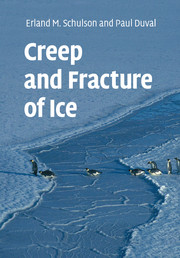Book contents
- Frontmatter
- Contents
- Preface
- Acknowledgements
- 1 Introduction
- 2 Structure of ice
- 3 Microstructure of natural ice features
- 4 Physical properties: elasticity, friction and diffusivity
- 5 Plastic deformation of the ice single crystal
- 6 Ductile behavior of polycrystalline ice: experimental data and physical processes
- 7 Modeling the ductile behavior of isotropic and anisotropic polycrystalline ice
- 8 Rheology of high-pressure and planetary ices
- 9 Fracture toughness of ice
- 10 Brittle failure of ice under tension
- 11 Brittle compressive failure of unconfined ice
- 12 Brittle compressive failure of confined ice
- 13 Ductile-to-brittle transition under compression
- 14 Indentation fracture and ice forces on structures
- 15 Fracture of the ice cover on the Arctic Ocean
- Index
- References
15 - Fracture of the ice cover on the Arctic Ocean
Published online by Cambridge University Press: 01 February 2010
- Frontmatter
- Contents
- Preface
- Acknowledgements
- 1 Introduction
- 2 Structure of ice
- 3 Microstructure of natural ice features
- 4 Physical properties: elasticity, friction and diffusivity
- 5 Plastic deformation of the ice single crystal
- 6 Ductile behavior of polycrystalline ice: experimental data and physical processes
- 7 Modeling the ductile behavior of isotropic and anisotropic polycrystalline ice
- 8 Rheology of high-pressure and planetary ices
- 9 Fracture toughness of ice
- 10 Brittle failure of ice under tension
- 11 Brittle compressive failure of unconfined ice
- 12 Brittle compressive failure of confined ice
- 13 Ductile-to-brittle transition under compression
- 14 Indentation fracture and ice forces on structures
- 15 Fracture of the ice cover on the Arctic Ocean
- Index
- References
Summary
Prologue In the late 1980s, following a presentation by one of us during a meeting of the Advisory Board of Dartmouth's Ice Research Laboratory, R. Weaver of the University of Colorado pointed out that he had seen in Defense Meteorological Satellite images of the winter sea ice cover on the Beaufort Sea features that resembled the wing cracks that one of us had just seen in laboratory specimens and had reported to the Board. The features,Figure 15.1, were dispersed amongst a variety of leads and open cracks and had the distinct markings of wing cracks: extensions, wide at the mouth and sharp at the tip, that had formed out-of-plane from the tips of inclined primary cracks. We estimated from wing-crack mechanics (Chapter 11) that a far-field compressive stress of around 3 kPa would have been needed to create them. W. D. Hibler then calculated the probable stress within the ice cover at the time of the sighting, from the historical record of wind fields, and obtained a value of between 7 and 14 kPa. We published the results shortly thereafter (Schulson and Hibler, 1991). Thus began an enquiry that forms the basis of this chapter and continues as we write: Is the physics of fracture independent of spatial scale?
Introduction
The sea ice cover on the Arctic Ocean during winter, as revealed through satellite images, generally contains oriented features.
- Type
- Chapter
- Information
- Creep and Fracture of Ice , pp. 361 - 390Publisher: Cambridge University PressPrint publication year: 2009



